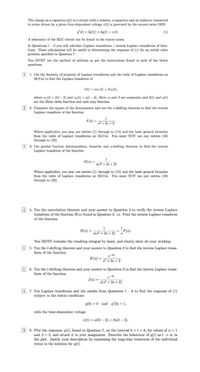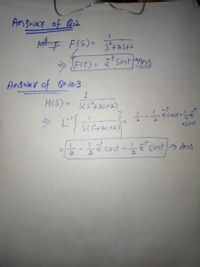
Advanced Engineering Mathematics
10th Edition
ISBN: 9780470458365
Author: Erwin Kreyszig
Publisher: Wiley, John & Sons, Incorporated
expand_more
expand_more
format_list_bulleted
Question
thumb_up100%
Uh need to solve only (question 4)
solve the q4 in one hour and get thumb up plz plz plz solve perfectly and handwritien soloution needed plz
I also attached the answers of q2 and q3
I need perfect soloution according to question requirements plz

Transcribed Image Text:The charge on a capacitor g(t) in a circuit with a resistor, a capacitor and an inductor connected
in series driven by a given time-dependent voltage v(t) is governed by the second-order ODE
"(t) + 20(t) +2q(t) = v(t).
(1)
A schematic of the RLC circuit can be found in the course notes.
.
In Questions 1 - 6 you will calculate Laplace transforms / inverse Laplace transforms of fune-
tions. These calculations will be useful in determining the response of (1) for an initial value
problem specified in Question 7.
You MUST use the method of solution as per the instructions found in each of the below
questions.
1 1. Use the linearity of property of Laplace transforms and the table of Laplace transforms on
MyUni to find the Laplace transform of
v(t) = av (t) + Buy (t),
where n (t) = 6(t – 2) and ty(t) = u(t – 3). Here, a and 8 are constants, and 6(t) and u(t)
are the Dirac delta function and unit step function.
2 2. Complete the square of the denominator and use the s-shifting theorem to find the inverse
Laplace transform of the function
F(e) = 7 +2 +2
Where applicable, you may use entries (1) through to (15) and the basic general formulae
from the table of Laplace transforms on MyUni. You must NOT use any entries (16)
through to (23).
5 3. Use partial fraction decomponition, linearity and s-shifting theorem to find the inverse
Laplace transform of the function
1
H(s) =
s(s + 28 + 2)
Where applicable, you may use entries (1) through to (15) and the basic general formulae
from the table of Laplace transforms on MyUni. You must NOT use any entries (16)
through to (23).
4 4. Use the convolution theorem and your answer to Question 2 to verify the inverse Laplace
transform of the function H(s) found in Question 3. i.e. Find the inverse Laplace transform
of the function
H(^) = »(² + 2» + 2) -F(0).
1
s(s² + 2s + 2)
H(s) •
You MUST evaluate the resulting integral by hand, and clearly show all your working.
1 5. Use the t-shifting theorem and your answer to Question 2 to find the inverse Laplace trans-
form of the function
e-2
K(s) =+28+2°
1 6. Use the t-shifting theorem and your answer to Question 3 to find the inverse Laplace trans-
form of the function
J(s) =
s(s +2s + 2)'
4 7. Use Laplace transforms and the results from Questions 1 - 6 to find the response of (1)
subject to the initial conditions
q(0) =0 and d'(0) = 1,
with the time-dependent voltage
v(t) = ab(t – 2) + Bu(t – 3).
3 8. Plot the response, q(t), found in Question 7, on the interval 0<t< 8, for values of a = 1
and B = 2, and attach it to your assignment. Describe the behaviour of q(t) as t + oo in
the plot. Justify your description by examining the long-time behaviour of the individual
terms in the solution for q(t).

Transcribed Image Text:Answer of Q:2
F FIS)- as2
> Flt)= ē*sintAns
Answer of ONo:3
%3D
XSint
int>
ē cost - ē's Ans
Expert Solution
This question has been solved!
Explore an expertly crafted, step-by-step solution for a thorough understanding of key concepts.
Step by stepSolved in 3 steps with 4 images

Knowledge Booster
Similar questions
- How do you solve this without getting an undefined answer?arrow_forwardwhen solving for distance, how can I find rate while time and distance are given to me? ex girl one travels 8 mph faster than girl two, after 5 hours their distance is 90?arrow_forwardPls help ASAP. Pls show all steps and work.arrow_forward
arrow_back_ios
SEE MORE QUESTIONS
arrow_forward_ios
Recommended textbooks for you
 Advanced Engineering MathematicsAdvanced MathISBN:9780470458365Author:Erwin KreyszigPublisher:Wiley, John & Sons, Incorporated
Advanced Engineering MathematicsAdvanced MathISBN:9780470458365Author:Erwin KreyszigPublisher:Wiley, John & Sons, Incorporated Numerical Methods for EngineersAdvanced MathISBN:9780073397924Author:Steven C. Chapra Dr., Raymond P. CanalePublisher:McGraw-Hill Education
Numerical Methods for EngineersAdvanced MathISBN:9780073397924Author:Steven C. Chapra Dr., Raymond P. CanalePublisher:McGraw-Hill Education Introductory Mathematics for Engineering Applicat...Advanced MathISBN:9781118141809Author:Nathan KlingbeilPublisher:WILEY
Introductory Mathematics for Engineering Applicat...Advanced MathISBN:9781118141809Author:Nathan KlingbeilPublisher:WILEY Mathematics For Machine TechnologyAdvanced MathISBN:9781337798310Author:Peterson, John.Publisher:Cengage Learning,
Mathematics For Machine TechnologyAdvanced MathISBN:9781337798310Author:Peterson, John.Publisher:Cengage Learning,


Advanced Engineering Mathematics
Advanced Math
ISBN:9780470458365
Author:Erwin Kreyszig
Publisher:Wiley, John & Sons, Incorporated

Numerical Methods for Engineers
Advanced Math
ISBN:9780073397924
Author:Steven C. Chapra Dr., Raymond P. Canale
Publisher:McGraw-Hill Education

Introductory Mathematics for Engineering Applicat...
Advanced Math
ISBN:9781118141809
Author:Nathan Klingbeil
Publisher:WILEY

Mathematics For Machine Technology
Advanced Math
ISBN:9781337798310
Author:Peterson, John.
Publisher:Cengage Learning,

